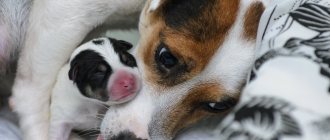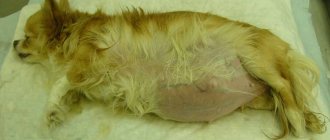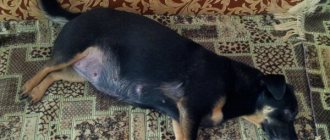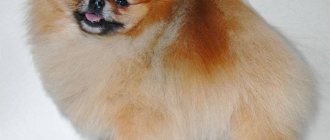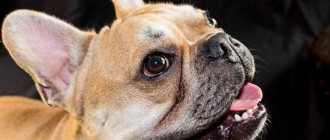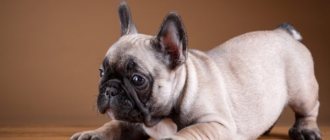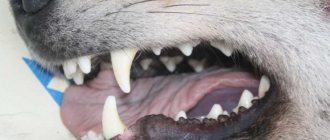Childbirth in dogs is a serious process that requires special preparation, as well as assistance from the owner. Before you give birth to a dog, you need to become familiar with the birth process itself and fulfill the requirements for a painless process.
The most important sign that labor is approaching is the animal's temperature. If in the normal state it is 38.5ºC, then before childbirth it drops to 36.5ºC, and maybe slightly lower. The temperature indicates that labor will occur in approximately 24 hours. Pregnancy in dogs lasts from 56 to 72 days. Over a period of several weeks, practically no changes are observed, but starting from 6 months, puppies can be felt. On the 50th day, the puppies begin to move, but before the onset of labor, no movements are observed. 7 days before the birth is allowed, it is necessary to prepare the delivery site. The article answers the question of how an animal gives birth, and also learn about caring for it after birth.
What is the oldest dog in the world?
Chanel; May 6, 1988, Newport News - August 28, 2009, Port Jefferson Station) was a dachshund dog who lived 21 years and 114 days. She was listed in the Guinness Book of Records as “the oldest living dog in the world.”
Interesting materials:
How much does a beginner graphic designer earn? How much does one truck earn per month? How much does Open Kids earn? How much does an Operations Director earn? How much does a hairdresser earn per month in Moscow? How much does a tiler earn in Germany? How much does a notary assistant earn in Ukraine? How much does a Rudn teacher earn? How much does a teacher earn at St. Petersburg State University? How much does a teacher at a university in St. Petersburg earn?
Childbirth in a dog. When should an owner worry?
Puppies can be born with their heads (the muzzle and front legs appear) or with their hind legs (the feet appear with the pads facing up). Both positions are correct. To make the bitch less tired, you can help her - while pushing, gently pull the part of the puppy that emerged from the loop. It is more convenient to pull by the hind legs (take it above the hock joint, you can pull by the head. Do not pull by the tail or toes (can be torn off) or by the jaw (can be broken). Give the born puppy to the mother, she will lick the newborn thoroughly. This is necessary for him to stimulate breathing and excretion of original feces. Sometimes bitches lick their puppies so actively that they tumble and roll to the side. Some owners are frightened by such violent manifestations of motherhood and try to take the puppy away from the bitch. Don’t be afraid, she won’t do anything bad to the puppy.
The interval between puppies varies . Usually the first 3-4 puppies are born at shorter intervals than subsequent ones. An interval of no more than an hour should be considered normal (but if two puppies appear at once, the interval before the next one may increase). Each subsequent puppy has to go through a longer birth path.
Newborn puppies have innate reflexes to search for food, they know how to find nipples and suck milk. They navigate by smell and heat. If the puppy cannot find the nipple, help him - squeeze out a drop of milk and place the nipple in his mouth. The first milk (colostrum) is very important for a newborn ; it contains antibodies and globulins that will help him cope with the new environment. Sometimes the puppy does not take the nipple in the first minutes after birth, do not despair, perhaps he had a difficult birth and needs to rest. After 15-30 minutes, invite him to try his hand again.
In the intervals between the birth of puppies, the bitch licks her firstborns. Puppies suck milk and this is very important, as it stimulates further labor. Offer the bitch to drink milk with tea, you can add a little sweet (this is the only case when a dog can have sweets).
To intensify labor in the intervals between the birth of puppies, take the bitch for a walk; it is useful to jog around the house; you can climb the stairs home, but it is not advisable to go downstairs. Just in case, they take a sheet for a walk, in case someone is born on the street.
If the bitch is very tired, give her a heart injection and glucose. Sometimes bitches begin labor very actively, and then the contractions stop. In such cases, calcium gluconate injections work well.
Keep records of the progress of labor . Record the time of birth of the puppy, gender, color, weight, characteristics. This will help you control the birth, and subsequently better distinguish between the puppies. The records look something like this: 1.23-30 marble male, 800 g, large black spot on the left shoulder, 2. 23-55 black female 780 g, white toes, round spot on the chest. And so on.
Childbirth does not always go smoothly. In our civilized and overly urbanized age, various complications during childbirth very often occur. In such cases, the owner’s main task is to call a veterinarian in a timely manner to provide qualified assistance. During the telephone conversation, be sure to discuss your actions before his arrival.
When should an owner be concerned?
- If, despite all the signs of pregnancy, labor does not occur on time.
- If there are signs of the preparatory period of labor, but labor itself does not occur, there are no contractions and attempts. With such signs, one can assume uterine atony, that is, the absence of labor.
- If there are attempts and strong contractions, but the puppy is not born. In such cases, you cannot wait long (an hour maximum), otherwise the dog will become very tired from fruitless attempts and, after helping in the birth of the first puppy, will be unable to continue labor. The reasons for this situation may be the large size of the puppy, its incorrect position in the uterus, or the inversion of the uterine horn.
- If only part of the puppy has appeared and, despite all the efforts of the bitch, it is not born. Most often this is due to the incorrect position of the fetal limbs. For example, if the puppy walks with its head, and you only see its muzzle and one paw. This means that the second limb in the shoulder is wrapped back and pressed against the body; the puppy in the shoulder girdle cannot pass through the bitch’s pelvic opening or through a narrow loop. This situation should be urgently discussed with a doctor, perhaps before his arrival you will be able to help the puppy. You can try to straighten his leg by holding him by the head (you need to act very carefully, using two fingers). Sometimes, if the puppy walks with his hind legs, his head gets stuck. In such cases, it is a little easier to help - at the moment of pushing, gently pull first on the legs, and when the body appears, on the torso.
- If a puppy is born dead or with any abnormalities (for example, premature, without hair). A dead puppy may be the result of injury or weak labor.
- If the bitch still has puppies in the uterus, and labor has stopped or greatly weakened.
- If a bitch has puppies in the uterus, active labor remains, and puppies are not born (that is, only part of the litter was born). One can assume inversion of one uterine horn or part of the horn.
- If after the birth of all the puppies there are placenta left in the uterus (that’s when keeping track of them will come in handy). Injections of contractile drugs, calcium gluconate, glucose with ascorbic acid are prescribed. It is imperative to monitor your body temperature.
- If after the cessation of labor you have doubts whether all puppies were born.
Caring for newborn puppies and dogs
In the first hours after the birth of puppies, it is recommended to contact a veterinarian if he was not present and did not deliver the child. Babies need to be examined for the development of pathologies. Also, the new mother herself, especially the first-born, may need help. You need to sound the alarm in the following situations:
- After giving birth, the bitch refuses to eat for a long period of time.
- Changes in breathing rhythm after labor ends. The dog breathes heavily and opens its mouth.
- There is a high temperature.
- Vaginal discharge after childbirth has an unpleasant odor, reminiscent of rotting. The color becomes more intense and the volume increases.
The main direction in caring for a female after childbirth is to prevent the development of complications. The owner must provide conditions for the speedy recovery of the pet’s body, so that the care and feeding of newborn babies is at the proper level.
Professional breeders recommend not allowing the female to eat more than 3 placenta. This will avoid the development of diarrhea in the animal. Hormonal substances contained in the placenta have a beneficial effect on the process of milk production and proper contraction of the uterus. The amount of clean drinking water should be sufficient, but it is recommended that the dog drink in small portions.
As soon as the birth process is completed, the pet needs to be given time to recover, giving complete rest. It is necessary to change the dirty bedding with smudges to a clean one and leave the new mother and puppies alone. If the place where the dog gave birth is not warm enough, you can additionally insulate the nest, protecting it from drafts.
The female's nutrition is clearly regulated by the owner. Food portions should not be large, meals should be frequent. It is recommended to give easily digestible foods - fermented milk products, low-fat fish. Gradually, the caloric content of the diet increases, as well as the size of the portions. The meat is added much later. A dog accustomed to eating dry food should be switched to a special one intended for nursing mothers in advance of birth. It is advisable to place a bowl of food and water in close proximity to the nest.
The dog should be bathed no earlier than 7 days after a successful birth. The paws and nipples are washed with warm water, preventing infection from entering the box with the offspring. It is also recommended to treat the genitals with antiseptic solutions.
What to feed a pregnant dachshund?
A pregnant dog needs to be fed properly. In the first three weeks, after the bitch becomes pregnant, her menu does not change fundamentally. The main part of the diet should be lean boiled meat (veal, chicken, rabbit), sea fish and chicken egg yolks. In the fourth week, the volume of servings for a pregnant dog is increased by 10%, and by the end of the second month - by 50%. It is worth increasing the frequency of feedings to 3-4 times.
You should not mix industrial and natural food; they should be given in a separate meal. At any stage of pregnancy, it is necessary to ensure constant access to fresh, clean water, which is changed several times a day.
Umbilical cord rupture after the birth of a puppy
After breaking the integrity of the amniotic sac, it is necessary to separate the umbilical cord. Dog breeders often argue about whether the dog needs to be helped in this, or whether it should complete this mission on its own. If the dog is not primiparous, then it itself gnaws the umbilical cord. Here it becomes necessary to ensure that she does not pull on it, because such an action leads to the formation of a hernia in the puppy. Dogs of toy and round-headed breeds that have bad teeth may need help. It is necessary to control an inexperienced animal, because it can harm the puppies when it ruptures the shell or chews the umbilical cord.
To separate the umbilical cord, you need to “milk” the blood in it towards the puppy. Then grab the umbilical cord at a distance of 2-3 cm from the abdomen and 2-3 cm from this place. With the hand that holds the puppy's umbilical cord, you need to make pulling movements; the umbilical cord breaks. The method is better than cutting in that it does not lead to bleeding.
If the umbilical cord is cut and blood appears, then it is necessary to tie the umbilical cord with a thread prepared in advance.
How can you tell if your dachshund is pregnant?
It is recommended to breed dachshunds not during the first heat, but during the third, when the dog is 1.5-2 years old and is fully formed physically and psychologically to become pregnant. In the first month it is very difficult to determine whether fertilization has occurred. From the fourth week after conception, signs of pregnancy appear:
- mucous discharge from the loop;
- toxicosis of a pregnant woman (nausea and vomiting);
- nipples become brighter than usual and increase in size;
- a pregnant dachshund's belly grows in volume;
- appetite changes - in the first month it may decrease, in the second it may increase.
It is guaranteed to know that a dachshund has become pregnant starting from the fourth week after conception with the help of special studies - measuring hormonal levels, a test or an ultrasound. Starting from the second month, the veterinarian determines the number of dachshunds in the pregnant woman by palpation. The owner should not do this on his own, so as not to harm the babies.
